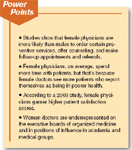Article
Women in Medicine: Making a difference, molding the future
More women in medicine may mean a healthier balance between patient care responsibilities and lifestyle—for all physicians.
During the past 40 years, women have become physicians in ever-increasing numbers. In 1964, according to the American Association of Medical Colleges, 6 percent of medical school graduates were female. By 1984, that number had risen to 28 percent, and by 2004 it was 46 percent.
The trend is as inexorable as it is unsurprising. Medicine is, after all, a line of work in which practitioners take care of people. And if stereotypes are at least partially grounded in fact, women have long been seen, and see themselves, as nurturers. Once women started entering the professional world in large numbers, the practice of medicine-especially family medicine, pediatrics, and obstetrics/gynecology-seemed a natural fit.
Females, however, aren't represented equally throughout the profession: Gastroenterology, neurology, and most of the surgical specialties remain male bastions. And men still dominate medicine as a whole. In 2003, according to the AMA, women comprised just 26 percent of the total physician workforce. But that's up from less than 8 percent in 1970. Indeed, according to the AMA the total number of physicians in the US increased by 86 percent between 1980 and 2003, while the total number of female physicians increased by 315 percent.
Does gender influence practice patterns?

Surprisingly, when Bertakis and Franks controlled for patient gender and health status, they found that differences in the amount of time spent with patients were statistically insignificant. "Female physicians have more female patients," says Bertakis, "and female patients report themselves as being in poorer health than males and require more time. Women physicians also see more new patients, and we all know that first visits are longer than follow-ups."
That's certainly the experience of Karen B. Weinstein, an internist in Oak Park, IL. Weinstein spends more time with patients than her two male partners do, but 80 percent of her patients are women, so naturally she does more Pap tests and breast exams.
Other physicians think that differences in visit duration reflect personality more than gender. "I know of many male and female doctors who are in and out of the exam room quickly, and several of both sexes who take the time to sit and listen," says Rivka Stein, a pediatrician in Brooklyn, NY. Stein, who likes to spend time with patients and their parents, educating and just chatting, adds that she thinks patients gravitate toward physicians who are like them. "I have had patients leave my practice because they prefer not to spend much time on a visit," she says.
Sherri L. Morgan, a family physician in Yellow Springs, OH, believes that patients expect women doctors to be more conversational and empathetic. Those who meet these expectations, Morgan says, do so because it comes naturally to them or because they've learned how to be better listeners. In her own case, if a patient, complains of, say, stomach problems, she'll do her usual workup and at the same time ask about the patient's family, marriage, and work situation to determine if the problem has an emotional component.





